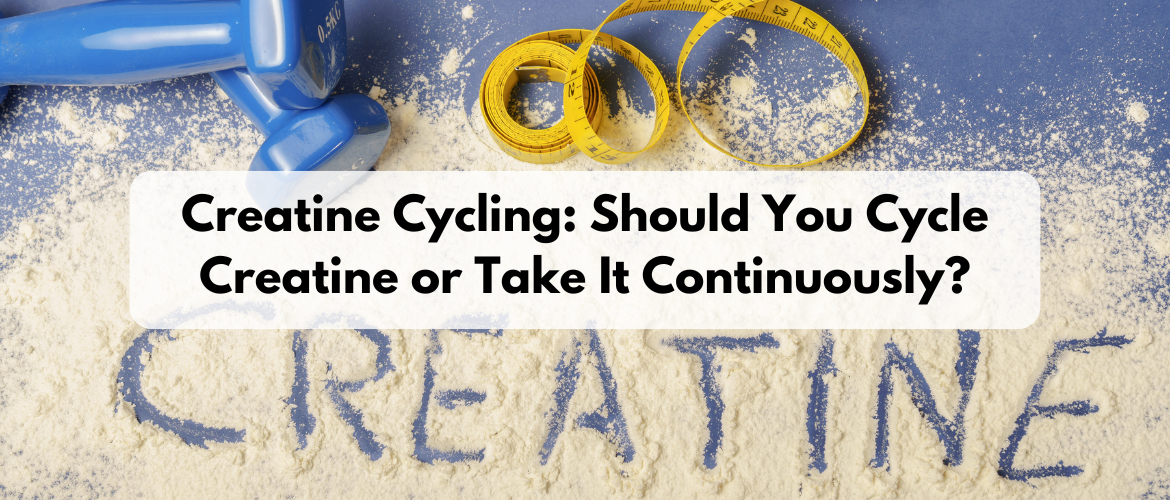No products in the cart.
Creatine Cycling: Should You Cycle Creatine or Take It Continuously?

Introduction: The Creatine Cycling Debate
Creatine is one of the most researched and widely used supplements for increasing muscle strength, power, and endurance. Fitness enthusiasts, bodybuilders, and professional athletes rely on creatine supplementation to improve high-intensity exercise performance and support faster muscle recovery.
However, a long-standing debate exists in the fitness community—should you cycle creatine or take it continuously without breaks? Some claim that cycling creatine enhances its long-term effectiveness by preventing the body from adapting to constant supplementation. Others argue that consistent daily intake provides continuous muscle saturation, maximizing creatine’s performance and recovery benefits without unnecessary breaks.
So, what’s the truth? Is creatine cycling beneficial, or is it better to take creatine without stopping? This detailed guide will explore the science behind creatine cycling, its potential benefits, drawbacks, and whether cycling is truly necessary for muscle growth, endurance, and overall athletic performance.
1. What Is Creatine Cycling?
Understanding the Concept of Creatine Cycling
Creatine cycling refers to the practice of taking creatine for a set duration (typically 6–8 weeks) followed by a break of 2–4 weeks before restarting the cycle. This process is similar to how some athletes cycle other supplements to reset the body’s response to supplementation.
The main theory behind creatine cycling is that the body adapts to constant creatine use, potentially diminishing its effectiveness over time. Some believe that taking breaks allows the body to stay responsive to creatine supplementation, leading to better muscle gains and improved performance when the cycle is restarted.
Different Methods of Creatine Cycling
There are several ways to cycle creatine, depending on your training goals, fitness level, and supplementation preferences:
✅ High-Dose Cycling Method: This approach involves taking 20g of creatine per day for 7–10 days (creatine loading phase), followed by a maintenance phase of 3–5g daily for a few weeks, then a complete break before repeating the cycle.
✅ Standard Cycling Method: Taking 5g per day for 6–8 weeks, followed by a 2–4 week break before starting another cycle.
✅ Periodic Cycling Method: Using creatine only during muscle-building phases (bulking, intense training periods) and stopping during cutting or rest phases.
While creatine cycling is a popular approach among some bodybuilders and athletes, scientific research suggests that cycling creatine is not necessary for maintaining long-term muscle benefits.
2. Potential Benefits of Creatine Cycling
1. Prevents the Body from Adapting Too Much
Some athletes believe that taking creatine daily for long periods may cause muscle cells to adapt, making creatine less effective over time. By cycling off creatine, muscles supposedly reset their sensitivity, allowing the body to react more strongly to supplementation when restarted.
While this idea sounds logical, research has found that muscle creatine levels remain saturated regardless of continuous supplementation. The body does not lose sensitivity to creatine, meaning this benefit may be overestimated.
2. Reduces Water Retention in Some Individuals
Creatine works by drawing water into muscle cells, leading to temporary water retention. Some users report feeling bloated or heavier when taking creatine consistently. Cycling off creatine may help reduce excess water weight, but this effect is often minor and temporary.
Water retention is not fat gain, and most users find that proper hydration and balanced electrolyte intake can minimize bloating while still taking creatine continuously.
3. Allows Athletes to Adjust Their Supplementation Strategy
Cycling creatine may allow individuals to experiment with other pre-workout supplements, dietary changes, or recovery strategies. Some athletes use break periods to assess their body’s natural strength levels without creatine supplementation.
However, taking creatine continuously does not prevent athletes from adjusting their overall nutrition and supplement intake, making this benefit largely a personal preference rather than a necessity.
3. Drawbacks of Creatine Cycling
1. No Scientific Evidence That Cycling is Necessary
One of the biggest arguments against creatine cycling is that scientific research does not support the need for periodic breaks. Studies show that muscle creatine levels stabilize after a few weeks of supplementation, and stopping supplementation does not enhance its effects when restarted.
There is no physiological reason to cycle creatine, as long as you maintain a daily dose of 3–5g to sustain muscle saturation.
2. Loss of Strength & Endurance During Breaks
Some users report a drop in strength, endurance, and workout intensity during creatine break periods. Since creatine supports ATP production, taking breaks may lead to temporary performance setbacks, especially for individuals relying on high-intensity training.
3. Complicated Supplementation Schedule
Creatine cycling requires tracking intake cycles and managing supplementation schedules. For many users, this adds unnecessary complexity when a simple daily intake of 3–5g provides continuous benefits.
4. Continuous Creatine Use: Is It the Better Option?
1. Maintains Consistent Muscle Saturation
Scientific research supports continuous creatine use, as muscle creatine stores remain elevated with daily supplementation. There is no evidence that the body stops responding to creatine over time.
2. Prevents Strength & Performance Drops
Continuous use ensures that ATP production remains consistent, preventing temporary dips in strength, endurance, and recovery that can occur during creatine cycling break periods.
3. Optimal Daily Dosage Without Cycling
For individuals who prefer steady supplementation, taking 3–5g daily maintains maximum muscle saturation without requiring unnecessary cycling.
5. Conclusion: Should You Cycle Creatine or Take It Continuously?
While creatine cycling is popular among some fitness enthusiasts, scientific studies do not support the need for periodic breaks. Taking 3–5g of creatine daily ensures continuous muscle saturation, enhanced strength, and optimal recovery, making cycling unnecessary for most users.
Unless you personally feel that cycling creatine helps with water retention, supplement rotation, or a psychological reset, there is no reason to interrupt supplementation if your goal is maximizing performance and long-term strength gains.
Key Takeaways:
✅ Creatine cycling is optional, but not scientifically required for effectiveness.
✅ Taking breaks may temporarily reduce water retention, but continuous use ensures long-term performance benefits.
✅ Daily intake of 3–5g maintains muscle saturation, preventing strength loss.
✅ Creatine is safe for extended use, with no need for cycling in healthy individuals.
For most users, consistent creatine supplementation without cycling is the best approach for maintaining peak athletic performance and muscle recovery! 🚀💪
Start your wellness journey today — Visit Unike Nutra Now
Follow us
Facebook – https://www.facebook.com/profile.php?id=61567462823245
Instagram – https://www.instagram.com/unikenutra/
Twitter – https://x.com/Unikenutra
LinkedIn: https://www.linkedin.com/company/unike-nutra/
Amazon: https://www.amazon.com/stores/UnikeNutra/






